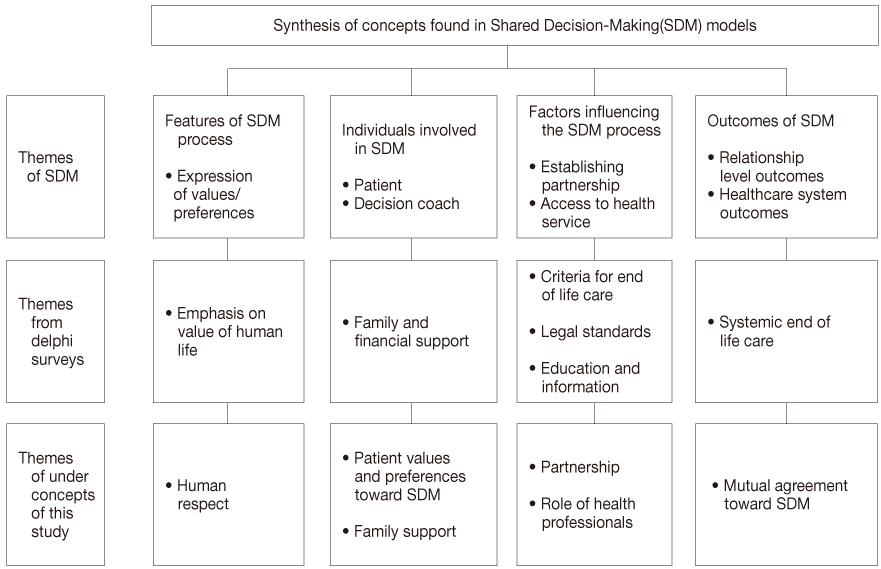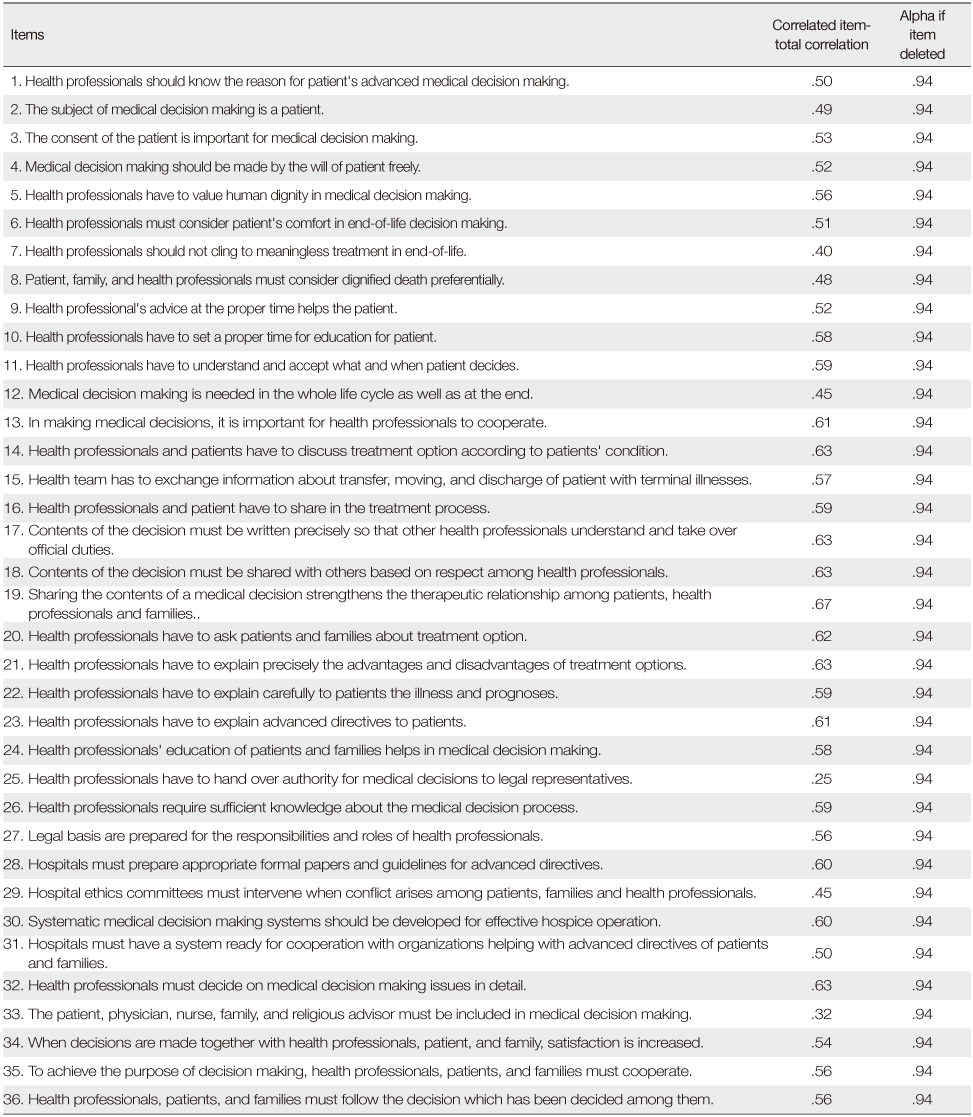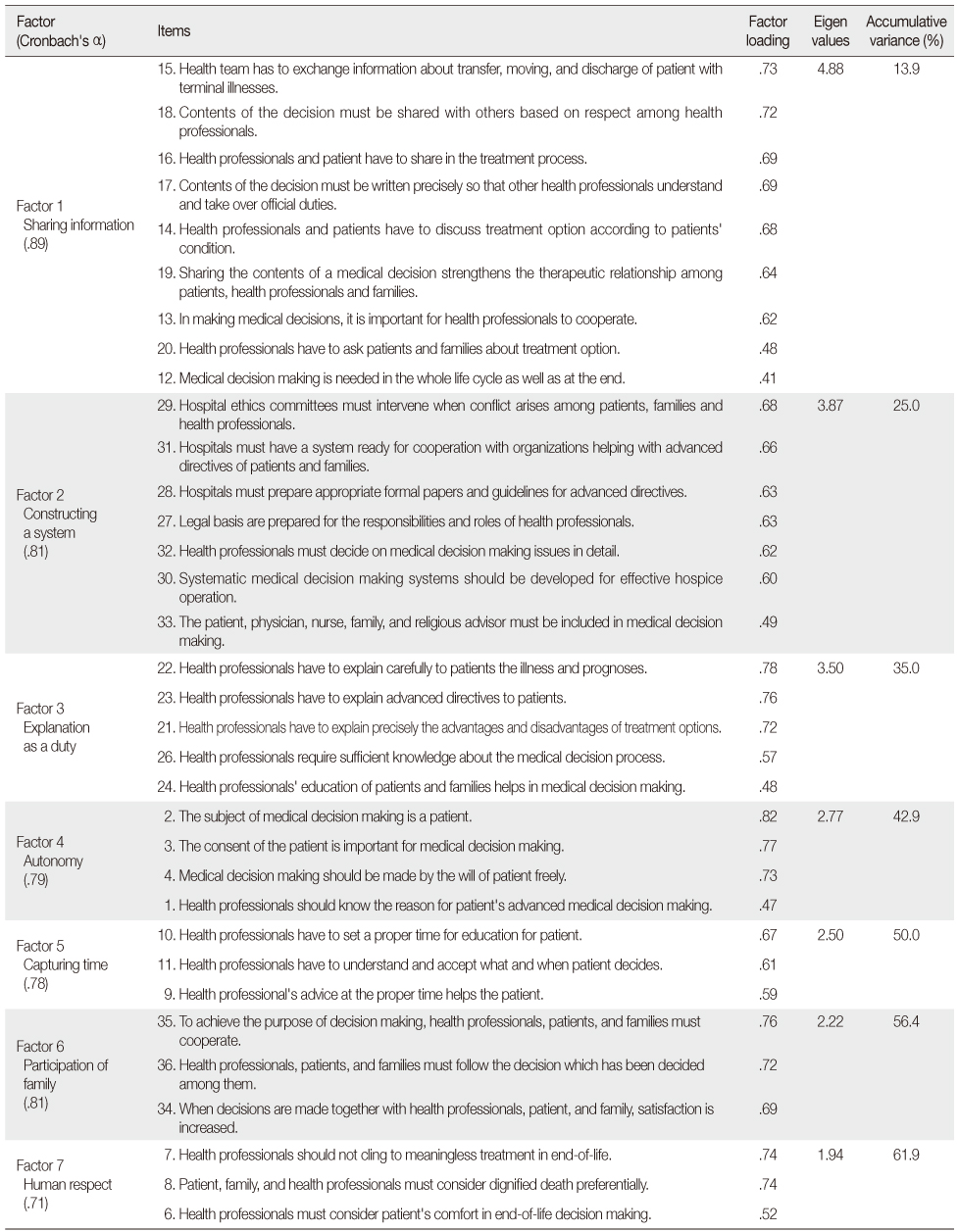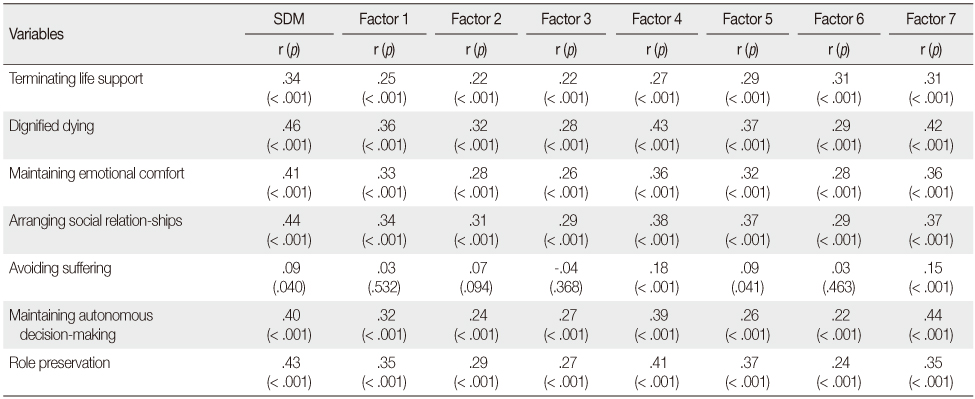Articles
- Page Path
- HOME > J Korean Acad Nurs > Volume 42(4); 2012 > Article
-
Original Article
- Development and Evaluation of Shared Medical Decision-Making Scale for End-of-Life Patients in Korea
- Kae Hwa Jo
-
Journal of Korean Academy of Nursing 2012;42(4):453-465.
DOI: https://doi.org/10.4040/jkan.2012.42.4.453
Published online: August 31, 2012
Catholic University of Daegu, College of Nursing, Daegu, Korea.
- Address reprint requests to: Jo, Kae Hwa. College of Nursing, Catholic University of Daegu, 3056-6 Daemyung 4-dong, Nam-gu, Daegu 705-718, Korea. Tel: +82-53-650-4825, Fax: +82-53-650-4392, jokw@cu.ac.kr
© 2012 Korean Society of Nursing Science
- 965 Views
- 14 Download
- 11 Crossref
Abstract
-
Purpose
- The study was done to develop a shared decision-making scale for end-of-life patients in Korea.
-
Methods
- The process included construction of a conceptual framework, generation of initial items, verification of content validity, selection of secondary items, preliminary study, and extraction of final items. The participants were 388 adults who lived in one of 3 Korean metropolitan cities: Seoul, Daegu, or Busan. Item analysis, factor analysis, criterion related validity, and internal consistency were used to analyze the data. Data collection was done from July to October 2011.
-
Results
- Thirty-four items were selected for the final scale, and categorized into 7 factors explaining 61.9% of the total variance. The factors were labeled as sharing information (9 items), constructing system (7 items), explanation as a duty (5 items), autonomy (4 items), capturing time (3 items), participation of family (3 items), and human respect (3 items). The scores for the scale were significantly correlated among shared decision-making scale, terminating life support scale, and dignified dying scale. Cronbach's alpha coefficient for the 34 items was .94.
-
Conclusion
- The above findings indicate that the shared decision-making scale has a good validity and reliability when used for end-of-life patients in Korea.
This research was supported by the Basic Science Research Program through the National Research Foundation of Korea (NRF) funded by the Ministry of Education, Science and Technology (2011-0004953).
- 1. Briggs L, Colvin E. The nurse's role in end-of-life decision-making for patients and families. Geriatric Nursing. 2002;23:302–310. http://dx.doi.org/10.1067/mgn.2002.130271.ArticlePubMed
- 2. Byun EK, Choi HR, Choi AL, Kim NM, Hong KH, Kim HS. An investigative research on the attitudes of intensive care unit nurses and families on terminating life support. Clinical Nursing Research. 2003;9(1):112–124.
- 3. Costello J. Nursing older dying patients: Findings from an ethnographic study of death and dying in elderly care wards. Journal of Advanced Nursing. 2001;35:59–68. http://dx.doi.org/10.1046/j.1365-2648.2001.01822.x.ArticlePubMed
- 4. Elwyn G, Hutchings H, Edwards A, Rapport F, Wensing M, Cheung W, et al. The OPTION scale: Measuring the extent that clinicians involve patients in decision-making tasks. Health Expectations. 2005;8:34–42. http://dx.doi.org/10.1111/j.1369-7625.2004.00311.x.ArticlePubMedPMC
- 5. Frank RK. Shared decision making and its role in end of life care. British Journal of Nursing. 2009;18:612–618.ArticlePubMed
- 6. Hilden H, Honkasalo M. Finnish nurses' interpretations of patient autonomy in the context of end-of-life decision making. Nursing Ethics. 2006;13:41–51. http://dx.doi.org/10.1191/0969733006ne856oa.ArticlePubMedPDF
- 7. Hilden H, Louhiala P, Honkasalo M, Palo J. Finnish nurses' views on end-of-life discussions and a comparison with physicians' views. Nursing Ethics. 2004;11:165–178. http://dx.doi.org/10.1191/0969733004ne681oa.ArticlePubMedPDF
- 8. Holcomb LE, Neimeyer RA, Moore MK. Personal meanings of death: A content analysis of free-response narratives. Death Studies. 1993;17:299–318. http://dx.doi.org/10.1080/07481189308252627.Article
- 9. Jo KH. Nurse's conflict experience toward end-of-life medical decision-making. Journal of Korean Academy of Adult Nursing. 2010;22:488–498.
- 10. Jo KH. Development and evaluation of a dignified dying scale for Korean adults. Journal of Korean Academy of Nursing. 2011;41:313–324. http://dx.doi.org/10.4040/jkan.2011.41.3.313.ArticlePubMed
- 11. Jo KH, An GJ, Kim GM. Future changes and directions for the construction of Medical Decision-Making System in Korea: Focused on delphi surveys. Korean Journal of Medical Ethics. 2011;14:44–54.
- 12. Johnston B, Smith LN. Nurses' and patients' perceptions of expert palliative nursing care. Journal of Advanced Nursing. 2006;54:700–709. http://dx.doi.org/10.1111/j.1365-2648.2006.03857.x.ArticlePubMed
- 13. Kriston L, Scholl I, Holzel L, Simon D, Loh A, Harter M. The 9-item shared decision making questionnaire (SDM-Q-9). Development and psychometric properties in a primary care sample. Patient Education and Counseling. 2010;80:94–99. http://dx.doi.org/10.1016/j.pec.2009.09.034.ArticlePubMed
- 14. Lee SM, Kim SY, Lee HS. The process of medical decision-making for cancer patients. Korean Journal of Medical Ethics. 2009;12:1–14.ArticlePDF
- 15. Lynn MR. Determination and quantification of content validity. Nursing Research. 1986;35:382–385.PubMed
- 16. Meraviglia MG, McGuire C, Chesley DA. Nurses' needs for education on cancer and end-of-life care. Journal of Continuing Education in Nursing. 2003;34:122–127.ArticlePubMed
- 17. Nordgren L, Olsson H. Palliative care in a coronary care unit: A qualitative study of physicians' and nurses' perceptions. Journal of Clinical Nursing. 2004;13:185–193. http://dx.doi.org/10.1111/j.1365-2702.2004.00816.x.ArticlePubMed
- 18. Norton SA, Talerico KA. Facilitating end of life decision making strategies for communicating and assessing. Journal of Gerontological Nursing. 2000;26:6–13.ArticlePMC
- 19. Ryu CS. SPSS 14.0 for windows. 2006;5th ed. Seoul, Elite.
- 20. Scherer Y, Jezewski MA, Graves B, Wu YB, Bu X. Advanced directives and end-of-life decision making: Survey of critical care nurses' knowledge, attitudes and experience. Critical Care Nurse. 2006;26(4):30–40.
- 21. Simon D, Schorr G, Wirtz M, Vodermaier A, Caspari C, Neuner B, et al. Development and first validation of the shared decision-making questionnaire (SDM-Q). Patient Education and Counseling. 2006;63:319–327. http://dx.doi.org/10.1016/j.pec.2006.04.012.ArticlePubMed
- 22. Song SJ. Characteristics of Korean family and family therapy. Korean Journal of Family Therapy. 2005;10:25–44.
- 23. Stacey D, Legare F, Pouliot S, Kryworuchko J, Dunn S. Shared decision making models to inform an interprofessional perspective on decision making: A theory analysis. Patient Education and Counseling. 2010;80:164–172. http://dx.doi.org/10.1016/j.pec.2009.10.015.ArticlePubMed
- 24. Stacey D, Murray MA, Legare F, Sandy D, Menard P, O'Connor A. Decision coaching to support shared decision making: A framework, evidence, and implications for nursing practice, education, and policy. Worldviews on Evidence-Based Nursing. 2008;5:25–35. http://dx.doi.org/10.1111/j.1741-6787.2007.00108.x.ArticlePubMed
- 25. Suh WS, Lee C. Impact of shared-decision making on patient satisfaction. Journal of Preventive Medicine and Public Health. 2010;43:26–34. http://dx.doi.org/10.3961/jpmph.2010.43.1.26.ArticlePubMed
- 26. Weissman DE. Decision making at a time of crisis near the end of life. Journal of the American Medical Association. 2004;292:1738–1743. http://dx.doi.org/10.1001/jama.292.14.1738.ArticlePubMed
- 27. Willard C, Luker K. Challenges to end of life care in the acute hospital setting. Palliative Medicine. 2006;20:611–615. http://dx.doi.org/10.1177/0269216306071064.ArticlePubMedPDF
- 28. Winter L, Parks SM. Family discord and proxy decision makers' end-of-life treatment decisions. Journal of Palliative Medicine. 2008;11:1109–1114. http://dx.doi.org/10.1089/jpm.2008.0039.ArticlePubMed
REFERENCES
Figure & Data
REFERENCES
Citations

- The effect of illness uncertainty and self‐efficacy on the perception of shared decision‐making among parents of infants in the neonatal intensive care unit
Dahae Choi, Hyewon Shin
Nursing in Critical Care.2025;[Epub] CrossRef - Influences of Nursing Professionalism, Empathy, and Clinical Decision-Making Ability on Shared Decision-Making Awareness among Hemodialysis Nurses
Junghwa Yun, Mihyeon Seong, Youngmi Cho, Sohyune Sok, Majed Alamri
Journal of Nursing Management.2024; 2024: 1. CrossRef - An exploratory study on the shared decision-making as a two-way symmetrical communication process : focusing on the communication of kidney dialysis patients
Soojin Kim, Soontae An, Sejoong Kim, Dong-Ryeol Ryu, Hwanhee Kim
Korean Journal of Journalism & Communication Studies.2021; 65(2): 162. CrossRef - Awareness of Doctors’ Shared Decision-Making in Life-Sustaining Care Decisions
Dalyong Kim, Hyun Jung Lee, Soo-Young Yu, Jung Hye Kwon, Hee Kyung Ahn, Jee Hyun Kim, Seyoung Seo, Chi Hoon Maeng, Seungtaek Lim, Do Yeun Kim, Sung Joon Shin
The Korean Journal of Hospice and Palliative Care.2021; 24(4): 204. CrossRef - The Perceptions and Needs of Hospice Palliative Care and Shared Decision Making among Middle-Aged Adults
Na-Yeon Lee, Seungjin Lee, Soo-Kyoung Lee
The Korean Journal of Hospice and Palliative Care.2016; 19(4): 310. CrossRef - Health Care Professional Factors Influencing Shared Medical Decision Making in Korea
Kae-Hwa Jo, Gyeong-Ju An, Hong Seon Lee
Sage Open.2015;[Epub] CrossRef - Effects of an educational programme on shared decision‐making among Korean nurses
Kae‐Hwa Jo, Gyeong‐Ju An
International Journal of Nursing Practice.2015; 21(6): 839. CrossRef - Types of Shared Medical Decision Making for Terminally Ill Patients
Kae Hwa Jo, Gyun Moo Kim
The Korean Journal of Hospice and Palliative Care.2014; 17(4): 278. CrossRef - Factors Affecting Shared Decision Making at End of Life in Korean Adults
Jo Kae-Hwa, An Gyeong-Ju
Holistic Nursing Practice.2013; 27(6): 329. CrossRef - The Impact of Nurses’ Attitude toward Dignified Death and Moral Sensitivity on Their End-of-Life Care Performance
Kae Hwa Jo, Yeon Ja Kim
The Korean Journal of Hospice and Palliative Care.2013; 16(4): 223. CrossRef - Preferences for Care near the End of Life according to Chronic Patients' Characteristics
Seonyoung Yun, Jiyeon Kang
Korean Journal of Adult Nursing.2013; 25(2): 207. CrossRef
- Figure
- We recommend
- Related articles
-
- Development and Evaluation of Evidence-Based Nursing Protocol for Extracorporeal Membrane Oxygenation to Critically Ill Patients
- Development and Validation of a Dignity in Care Scale of Terminally Ill Patients for Nurses
- Development of the Hybrid Clinical Practicum Environment Scale for Nursing Students

Figure 1
Item Analysis (N=388)
Item deleted by item analysis.
Factor Analysis and Reliability (N=388)
Kaiser-Meyer-Olkin (KMO)=.94; Bartlett's test of sphericity: χ2=10,388.58; p<.001; Cronbach's α=.94.
Correlation among Shared Decision Making Scale, Terminating Life Support Scale, and Dignified Dying Scale (N=388)
SDM=Shared decision making.
Item deleted by item analysis.
Kaiser-Meyer-Olkin (KMO)=.94; Bartlett's test of sphericity: χ2=10,388.58;
SDM=Shared decision making.
 KSNS
KSNS
 E-SUBMISSION
E-SUBMISSION




 Cite
Cite

